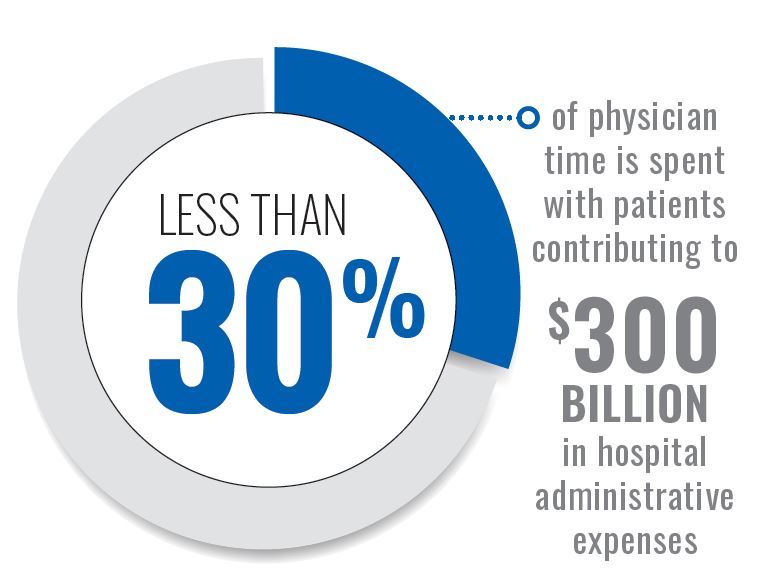Time Study: Delivering time intelligence to health enterprises
How do you help healthcare organizations?
Launched in 2017, Time Study provides a centralized time intelligence platform for hospitals and health systems, gathering time data from different sources across the enterprise to create a comprehensive profile of how healthcare providers spend their time at work. Organizations use our platform in the following ways:
- Evaluate workforce. Robust time data lets organizations assess the efficiency of their current workforce and determine how much time providers spend at the top of their licenses, which guides the organization in redesigning processes to improve practitioner satisfaction and potentially increase billable time.
- Optimize workflows. By responding to insights found in time data, organizations can reduce redundancies, improve efficiencies and better allocate resources.
- Meet regulatory requirements. Organizations use our solution to engage in more accurate cost reporting as it allows them to clearly delineate Medicare Part A and Medicare Part B time. Such data also helps correctly report time spent on grants and research studies. For graduate medical education (GME) program compliance, organizations can easily see what percentage of time is spent supervising residents. For transplant program compliance, organizations can note what percentage of time is spent per organ and pre- and post-transplant.
The premise on which Time Study is based is that a good deal of time data already exists within an organization, but entities are not accessing it because it’s found in siloes across the enterprise. The Time Study platform offers one place to make sense of all the data, delivering valuable information to multiple stakeholders in formats they can use.
What are some of the biggest challenges you see affecting healthcare organizations?
One of the largest hurdles is the data silos that currently exist in most organizations. Not only do these make it hard to access and interact with time data, the information itself is sometimes inaccurate due to poor data collection methods. We’ve found that 40% of recalled time data is inaccurate in part due to how the information is collected. Incorrect data yields unreliable insights, suboptimal cost reporting and other negative consequences. It’s also difficult to uncover revenue leakage if the data is not accurate. For example, how can you correctly quantify uncompensated time when you don’t have a holistic profile of time being spent?
Another challenge is that less than 30% of physician time is spent with patients contributing to $300 billion in hospital administrative expenses each year.a A large portion of physician time is consumed by filling out paperwork and performing other administrative duties. To streamline operations while increasing patient and provider satisfaction, organizations should try to limit provider administrative tasks and increase the amount of time professionals work at the top of their licenses. Our goal with Time Study is to curb the self-reporting of time and instead leverage existing data sources that are more accurate, comprehensive and less burdensome. Moreover, we can identify top-of-license activities and show whether providers are regularly engaged in these tasks, enabling administrators to make changes in their workflow and staffing to free practitioner time to focus on patients.

How does your service offering address these needs?
Organizations that have used the Time Study solution have been able to make meaningful improvements in efficiency, workforce optimization and compliance. For example, our platform has helped several entities increase research grant and Medicare and Medicaid compliance rates by 150% and boost reimbursement by half a million dollars.
Our state-of-the-art technology pulls and validates data from systems across an organization, including electronic health record (EHR), payroll, billing, and time and attendance software. The solution can also pull information from messaging systems where practitioners communicate with the rest of the care team. Our platform integrates with structured and unstructured datasets, transforming the data into dashboards and insights that meet each stakeholder’s unique needs. Through our system, organizations can spot improvement areas and respond in real-time via the system’s visualization and messaging capabilities.
The Time Study solution leverages emerging technologies to create a more comprehensive time profile. For instance, the platform uses natural language processing and machine learning to transform unstructured data sets from rich text fields into standardized information in structured fields. We also employ artificial intelligence to support predictive analytics. As organizations begin to use our system, we’re able to predict how much time a person would spend on an activity based on his or her behavior patterns.
What are some key considerations for healthcare leaders when choosing this type of service?
Look for a partner that is committed to understanding why an organization is collecting time data, what data its already collected and whether the existing data adequately meets stakeholder needs. By working with a knowledgeable vendor that explores the root causes of certain requests and has a clear picture of current data assets, you can be more confident that the right people will get the information they need in the format and timeframe in which they need it.
What advice would you offer to healthcare leaders when choosing among vendors?
Consider the vendor’s long-term mission and make sure it aligns with your organization’s goals. Reducing overhead in an organization requires a journey. Although hospitals and health systems may initially partner with us on a specific use case, like improving cost reporting workflows, the potential advantages of our system for more strategic improvement quickly become evident. We are committed to embarking on a journey with our customers to decrease administrative overhead across the board and identify more workforce efficiencies for greater revenue and practitioner satisfaction.
A key part of our road map is eliminating self-reported time. Because we believe there’s a lot of data already available, we seek to unlock it and prevent staff and practitioners from having to stop their work to reflect and quantify what they’ve been doing for the last month. While we provide tools that allow organizations to realize value on day one, such as being able to collect time studies for cost reports, our overall mission is to streamline time data collection and reporting so providers can deliver better value to patients.
As healthcare organizations implement use of your service into their day-to-day operations, what advice would you offer so they can best set themselves up for success?
A first step involves conducting a data inventory to understand what data is available in the organization today. Also, it’s helpful to have a clear list of the stakeholders who require time data and the outputs they need, including any relevant key performance indicators (KPIs) and other metrics. Many organizations make the mistake of hurrying into the build phase instead of taking time to fully inventory their existing data assets and needs, including whether they have unstructured data to analyze. A careful evaluation can uncover several root causes that prevent effective data use, such as not enough of the right data, biased datasets, inaccessible data, lack of collaboration between stakeholders and so on. Organizations can address some of these roadblocks as they work with our solution.
Getting the most out of our system is not something that happens overnight, and organizations should not worry if they don’t become fully “time intelligent” immediately. It’s most important to take small but meaningful steps toward more long-range goals. Every win along the way should deliver value to practitioners and patients in terms of improving efficiency, satisfaction and care quality.
How can healthcare organizations learn more about your company?
To learn more about Time Study and how to prepare your organization for enterprisewide time intelligence, go to www.TimeStudy.co.
Footnotes
a. Dinerstein, C., “How Do Doctors Spend Their Time?” American Council of Science and Health, April 16, 2019.

In this Business Profile, Kishau Rogers, founder and CEO of Time Study, discusses the value of centralized time intelligence to improve organization performance, efficiency, staff satisfaction and compliance.
Time Study
Our time intelligence platform helps organizations and their employees gain mastery over how they spend their time. We believe that leveraging technology to optimize how time is spent is the future of work and the key to creating more value for the enterprise’s greatest resource, people. By ingesting datasets – structured and unstructured – from across the organization and matching them to stakeholder intent, we help organizations discover insights and take action. We proudly serve the largest health organizations including NY-Presbyterian and Stanford. Our partnerships drive key metrics such as physician engagement by 150%.





